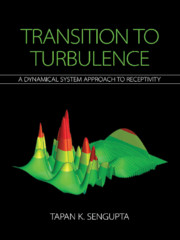Book contents
- Frontmatter
- Dedication
- Contents
- Preface
- 1 Receptivity, Instability, and Transition: A Perspective
- 2 Dynamical System Theory and Role of Equilibrium Flows
- 3 Fundamentals of Scientific Computing
- 4 Instability and Transition
- 5 Receptivity Analysis: Relation with Instability Experiments
- 6 Dynamical System Theory of Linear Receptivity
- 7 Nonlinear, Nonparallel Effects on Receptivity, Instability, and Transition
- 8 Three-Dimensional Routes of Transition to Turbulence
- 9 Receptivity to Free Stream Excitation: Theory, Computations, and Experiments
- 10 Nonlinear Receptivity Theories: Hopf Bifurcations and Proper Orthogonal Decomposition for Instability Studies
- 11 Mixed Convection Flow
- 12 Baroclinic Instability: Rayleigh–Taylor Instability
- 13 Coherent Structure Tracking in Transitional and Turbulent Flows
- 14 The Route of Transition to Turbulence: Solution of Global Nonlinear Navier–Stokes Equation
- References
10 - Nonlinear Receptivity Theories: Hopf Bifurcations and Proper Orthogonal Decomposition for Instability Studies
Published online by Cambridge University Press: 16 February 2021
- Frontmatter
- Dedication
- Contents
- Preface
- 1 Receptivity, Instability, and Transition: A Perspective
- 2 Dynamical System Theory and Role of Equilibrium Flows
- 3 Fundamentals of Scientific Computing
- 4 Instability and Transition
- 5 Receptivity Analysis: Relation with Instability Experiments
- 6 Dynamical System Theory of Linear Receptivity
- 7 Nonlinear, Nonparallel Effects on Receptivity, Instability, and Transition
- 8 Three-Dimensional Routes of Transition to Turbulence
- 9 Receptivity to Free Stream Excitation: Theory, Computations, and Experiments
- 10 Nonlinear Receptivity Theories: Hopf Bifurcations and Proper Orthogonal Decomposition for Instability Studies
- 11 Mixed Convection Flow
- 12 Baroclinic Instability: Rayleigh–Taylor Instability
- 13 Coherent Structure Tracking in Transitional and Turbulent Flows
- 14 The Route of Transition to Turbulence: Solution of Global Nonlinear Navier–Stokes Equation
- References
Summary
Introduction
It has already been explained how linear theories display unconditional stability for flow in a pipe and plane Couette flows. Even for plane Poiseuille flow, the computed critical Reynolds number obtained by linear theory is about almost six times higher than that has been observed experimentally by Davies and White [106]. Also, of interest is the classical experiment of Reynolds [203] for the pipe flow, in which the critical Reynolds number was raised to a value of 12,830 after careful control of the experimental conditions. Monin and Yaglom [295] noted that “in the case of a tube with sharp entrance, pushed through the plane wall of the reservoir, the end of the tube will create considerable disturbances, and Recr will equal approximately 2800. Conversely, if the degree of disturbance at the intake into the tube is decreased strongly by some means or other, we can delay the transition from laminar to turbulent flow until very high Reynolds numbers.” It has been noted that Pfenninger [332] could delay transition in pipe flow for up to Re = 100, 000, by arranging twelve special screens to damp disturbances in the flow approaching the inlet of the tube. Interestingly, Reynolds [203] noted the events in his experiments “at once suggested the idea that the condition might be one of instability for disturbance of a certain magnitude and stable for smaller disturbances.” While the relation between response with amplitude of input is an attribute of nonlinear instability, authors in [295] interpret the situation somewhat differently by concluding that “Reynolds number in itself is not a unique criterion for transition to turbulence; for a flow in a tube it is apparently impossible to find a universal critical value of Recr such that for Re ≥ Recr the flow regime is bound to be turbulent. To establish the upper value of Re for laminar flows in tubes it is necessary to have some knowledge of the level of inlet turbulence of the laminar flows considered.” To support this conjecture, a figure showing the variation of Reynolds number at transition is plotted against turbulence intensity in Figure 10.1 for flow over a zero pressure gradient boundary layer.
- Type
- Chapter
- Information
- Transition to TurbulenceA Dynamical System Approach to Receptivity, pp. 343 - 398Publisher: Cambridge University PressPrint publication year: 2021



